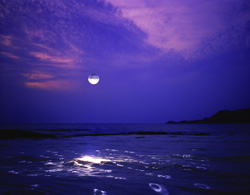

 When Yeondoo Jung first launched his Bewitched project a few years ago, his starting premise was that the artist might serve as the vehicle for transforming the dreams of a typical post-adolescent into a tableau vivant makeover for camera. In this series, the same person is photographed twice, first in his or her everyday setting, and then, using the same body position, as the star of a fantasy aspiration come true (a gas station attendant becomes a race car driver). Exhibitied side by side as twin slide projections, the Bewitched series played with the conventions of before-and-after photography by giving us a kind of ‘proof’ that even when the outer trappings of material achievement change, the person remains, at heart, pretty much the same.
When Yeondoo Jung first launched his Bewitched project a few years ago, his starting premise was that the artist might serve as the vehicle for transforming the dreams of a typical post-adolescent into a tableau vivant makeover for camera. In this series, the same person is photographed twice, first in his or her everyday setting, and then, using the same body position, as the star of a fantasy aspiration come true (a gas station attendant becomes a race car driver). Exhibitied side by side as twin slide projections, the Bewitched series played with the conventions of before-and-after photography by giving us a kind of ‘proof’ that even when the outer trappings of material achievement change, the person remains, at heart, pretty much the same.
Since the success of Bewitched, Jung has returned to making still photographs, but his current approach more explicit prioritizes the staged over the spontaneous. With Locations, Jung’s starting-point is the creation of a tableau in which the studio effects used to create a particular illusion of nature are incorporated into the photograph. For example, the artist set off not long ago on a mountain climbing expedition with a team of assistants. With them they carried all the bits of stagecraft needed to fabricate an artificial cliff-face, which was then angled within the frame of the final photograph so that it became visually aligned with the actual mountains in the distance (on which a real alpinist is ascending). Strategically positioning at the photo’s center a studio model who semi-convincingly simulates her own struggle to reach the summit, Jung also permits the wooden armature inside the fabricated mountain to peek sheepishly into the frame.
The Locations photographs emerge out of a genuine desire on the artist’s part to capture something of the mystery of the wilderness (or related natural phenomenon), but to do so in a way that collapses the distinction between what nature is and what we bring to it. Jung also seems to wish to remind us of two different points: that the search for natural beauty does not always need to lift us out of our artificial environment, and that we are often unable to appreciate natural beauty until we hold up the artificial for comparison.